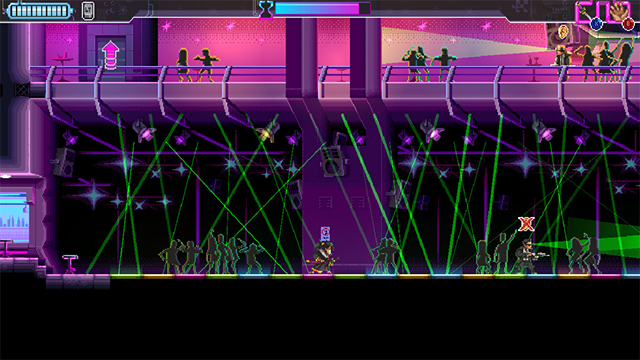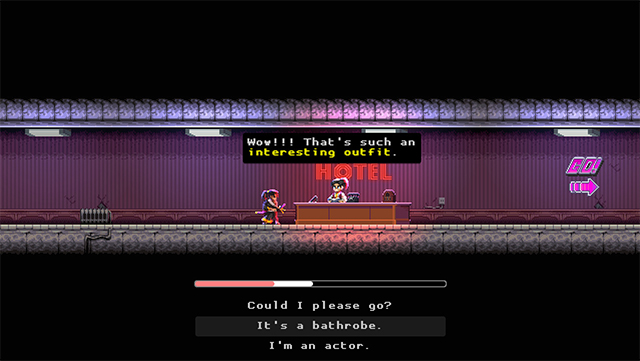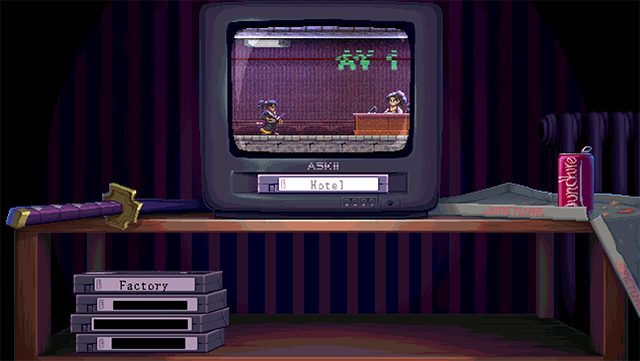After six long years, developer Justin Stander is finally about to release his baby, Katana Zero. This neo-noir, action platformer has been in development for about six years and is finally about to hit the Switch and PC. Despite some help, Stander developed the game almost exclusively by himself from the design to the programming; quite a feat for how much it impressed us earlier this month. So how does one person create a game with such tight controls and an impressive amount of detail? Stander sat down with us and talked about how he did it along with why he committed so hard to the game’s narrative.
GameRevolution: There are a lot of masocore sort of games in the indie space where the focus is on quick, punishing gameplay. How does Katana Zero stick out?
Justin Stander: I’ve been working on it for a lot longer than these people. And I’ve been making games for probably a lot longer than these people. I’ve been doing it since 2004 or something like that and this is always the sort of game that I’ve always wanted to make since the very beginning.
Like this instant death, super difficult, very forgiving game where you always feel like it’s your fault not the game’s fault so you want to try one more time because you know what you did wrong. It’s just this sort of game design that I’ve done since the very beginning. I feel like I’ve sort of mastered it. And just the production value in this game, I feel, is several notches above most of the other people who are attempting it. Just every little detail has really been agonized here.
And story-wise, I haven’t really found another game in that genre that has this depth of plot and narration.

GR: So it’s easy to say you want to make fair but hard gameplay that sounds super difficult. How do you do achieve that goal?
JS: You have to make the engine flawless. No bugs. Everything needs to feel like an extension of the player. When you play it, you should always feel like this is exactly what I wanted to do and that is what the character did. It has to feel like enough controls and tools to be able to do everything you wanted to do.
And this is an important part as well, instant death is a simple mechanic. You need to be able to make a game around that and keep things fresh for however many hours the game is. And I think that is the most difficult part where finding the core loop is simple but you need to find out how to keep players’ attention throughout a game and story that is several hours.
GR: How do you keep it fresh?
JS: New enemies, mechanics, and the plot. I really love to defy expectations in this game. As soon as you think you understand how this game is going to play out, then I just try to completely shift it on you. So even at the beginning of the game, you think there’s this format of you kill people, you go to sleep in your apartment, then you go to your psychiatrist and he’ll give you your next job and you continue to go in that format. And as soon as you comfortable in that, I try to shift things up. And I do that several times throughout the game. I really mess with the player.
Plot-wise, it keeps you on you on your toes. Gameplay-wise, I just throw a lot of stuff in there like lots of new enemy types, new hazards, ways to kill the enemies using the environment, different level layouts. There’s one where it has multiple floors and you can choose any order and each one is themed after a different movie set.
Like there’s an Indiana Jones and the Temple of Doom parody called the Chapel of Doom and you ride a minecart through it and you hop off and kill enemies. So it’s a lot of little mechanics. That one minecart level took well over a month of development just to make the minecart. An incredible amount of patience has put into little aspects in this game because everything is very cinematic and feels unique and built around these set pieces.

GR: The soundtrack seems important as the main character turns on a Walkman in the beginning of each level. What is the significance of that?
JS: One of the interesting components of that is when he goes to talk to someone, he’ll take an earpiece out and the music will change. It’s a very nice device for framing how sound works in the game. When you use slow motion in the game, the music also slows down with you because the character is perceiving the music in his ear so when he slows down time, the music would naturally slow down there too.
It’s a game that I’ve been working on for six years so every single aspect has so many little details that I’ve agonized over so hopefully it shows.
GR: The story seems a lot deeper than games of this genre. There are dialogue options and other choices. What does that affect?
JS: The way that you understand the world and the way characters interact with you or how characters die and don’t show up again. Basically, the way the story is told is entirely dependent on your choices in these dialogue sequences and your choices in the gameplay segments as well.
So every little choice you have has small ripple consequences. Not everything is as important as each other but there are hundred and hundreds of choices throughout these cutscenes and the idea is to really think the player always has agency while they’re playing. They are never spoonfed the story from an arm’s length. Instead they are always directly engaged which is why there is an interrupt feature. It directly plays into how the player wants to play the game.
If the player is impatient and they don’t want to read the dialogue and they just want to play the gameplay, then the game is completely willing to do that. You can interrupt someone once or twice and they’ll get too pissed off and they won’t want to talk to you again. You totally cleared that portion of the dialogue but you as the player and character have no idea what is going on in the game world. And that is completely reflected in the dialogue choices and the story that appears later on because lots of things will disappear if you don’t do you due diligence and pay attention to what is going on.
GR: Can you give an example?
JS: Yes. In this level, you’re supposed to kill these targets. And in both of those targets, you can just straight up kill them. Like at the beginning of the dialogue, as soon as you start talking to them, the option to kill them appears. So you can always do that and immediately end it, kill your mark, and be done with it. Or you can wait and listen to what they have to say. Maybe some strange things will happen. It’s always a viable option.
Like if you talk to the DJ and don’t kill him immediately, you’re not following your orders. And that strains a relationship with your handler. And it also opens up different paths because he tells you things you weren’t supposed to hear. So it starts opening paths of intrigue where you can start questioning what is going here. Or you can just be completely compliant, kill him, and never even understand that something like that is going on at the same time.

GR: I interrupted the otaku person at the lobby of the hotel multiple times in that one level. How would that have worked if I had been nice?
JS: There are actually a lot of things that change throughout the game from that conversation. Even just within that specific level, because you interrupted her and then she became pissed off, at the end, she immediately sells you out the cops and you have no alibi to get out of there because normally, if you have an alibi, you can talk your way out without any additional combat.
And at the end of the level, because she ran away into all this violence, she was terminated by your handler. So that does change how other things play out later in the game. And your alibi will come up again. Every little bit that you do in this game does have ripple consequences that go throughout the game.







